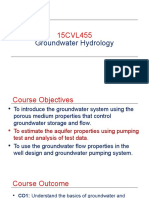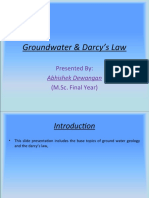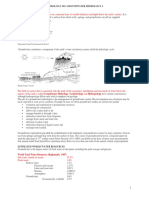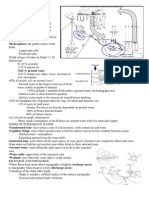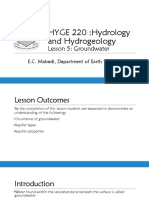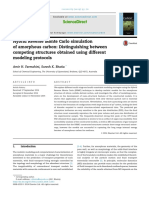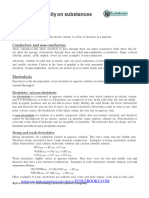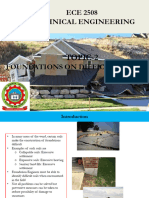HYDROGEOLOGY
Hydrology is the study of water in its broadest sense including occurrence, distribution, movement
and chemistry of all waters of the earth. Hydrogeology encompasses the interrelationships of
geologic materials and processes with water. (A similar term, geohydrology is sometimes used as a
synonym for hydrogeology, although it more properly describes an engineering field with
subsurface fluid hydrology).
The term groundwater is usually reserved for the subsurface water that occurs beneath the water
table in soils and geologic formations that are fully saturated. In this course we shall retain this
definition with emphasis on the shallow saturated groundwater flow, although moisture transport in
the unsaturated zone and the groundwater in much deeper saturated zones will be discussed later as
well.
This lecture is about groundwater, and more specifically about
1. the geologic environments which control the occurrence of groundwater
2. the physical laws which describe the flow of water
3. the chemical evolution which accompanies flow
4. the interrelationship between man and natural groundwater regimes
The study of groundwater is interdisciplinary in nature. The hydrogeologist usually has training in
geology, hydrology, chemistry, mathematics and physics. Hydrogeologists are also being trained in
such areas of engineering as fluid mechanics and flow through porous media, as well as in
computer science. Such training is necessary, as hydrogeologists must be able to communicate
effectively with engineers, planners, ecologists, resource managers and other professionals. By the
same token, an understanding of the basic principles of hydrogeology is useful to soil scientists,
engineers, planners, foresters and others in similar fields.
Traditional hydrogeological studies have focused on either the mathematical treatment of flow
through porous media or on a general geologic description of the distribution of rock formations in
which groundwater occurs.
More recently, hydrogeologists are being employed as problem solvers and decision makers. More
and more hydrogeology is being recognized as an important part of environmental planning. As
population increases, human use of the natural environment is becoming more intense with all the
associated dangers of environmental degradation.
The traditional role of the hydrogeologist has been the location and development of groundwater
supplies. In southern Africa and many developing countries with serious recurrent spells of drought
there still is an urgent need for development of long-term groundwater supplies. Surface water
supplies are especially vulnerable to bacterial and viral contamination.
In many developed countries disposal of industrial and municipal waste has resulted in
groundwater contamination by
1
� 1. hydrocarbons
2. pesticides and fertilizers (agriculture !)
3. radionuclides
4. organic solvents
5. metals
Mining activities, municipal landfills, road salting, septic tanks have added to the problems.
While there is great concern over the amount of contamination, it has been pointed out that only
two percent of the available resources have been contaminated. Unfortunately the contamination
areas are centered around densely populated areas.
2
�A. The Hydrological Cycle
Saline 97.2 %
Fresh 2.8 %
ice caps, glaciers 2.14 %
groundwater 0.61
soil moisture 0.005
fresh water lakes 0.009
rivers 0.0001
98% of the available fresh water is groundwater
The Hydrological Balance
Inflow=Outflow +Change in Storage
3
�4
�B. Aquifer Types
An aquifer is a geologic unit that can store and transmit water at rates fast enough to supply
reasonable (economic) amounts to wells
A confining layer is a geological unit that can transmit very little water:
Aquifuge absolutely impermeable, will not transmit any water
Aquitard low permeability, may hold water
Aquicludes low permeability, aquifer boundary
The following terms are often used:
Confining layer
Leaky confining layer
The main aquifer types are usually distinguished in:
Confined aquifers
Unconfined, phreatic or water table aquifers
Semi-confined aquifers
Perched
C. Porositv of materials
Double porosity
primary porosity: spaces (voids) between individual grains
secondary porosity: fractures, joints, dissolution cavities, vesicles, etc.
Some books use the following terminology:
porous aquifers
fractured aquifers
fractured porous aquifers
Definitions:
1. porosity
Vv volume voids
n= = (1)
Vt total volume
2. void ratio
Vv volume voids
e= = (2)
Vs volume solids
5
�3. relations between n and e
e
n= (3)
1+ e
n
e= (4)
1− n
Note: effective porosity ne is the porosity available for fluid flow
4. Saturation ratio Rs .
Vw
Rs = (5)
Vv
5. Water content
a. by weight
weight of water
w= (6)
dry soil weight
b. by volume
volume of water
θ= (7)
total volume
6. Specific yield Sy
That part of the porosity that can be drained by gravity (field capacity)
7. Specific retention Sr
That part of the porosity that cannot be drained by gravity
8. n=Sy+Sr .
6
�D Principles of flow
Flow rate Q m3s-1
Specific discharge (or Darcy velocity) v ms-1
(in the unsaturated zone we also use q for the flux density)
Cross-section A m2
pipe
cross-section
A
vs=v
Q=vA
aquifer
cross-section
A
vs=v/ne
Q=vA
Q = vA (8)
vs is the seepage velocity or linear velocity, defined as
Q
vs = (9)
ne A
The seepage velocity is therefore always greater than the specific discharge v. It is the average
molecular velocity in the direction of flow, whereas the specific discharge v is a measure of the
amount of water that flows through a given cross-section A per second.
7
�E. Hydraulic head
Is defined as the potential energy per m3, expressed in m water
h hydraulic head
z elevation head h = h p+ z
hp pressure head
h
hp
datum
8
�F. Darcy’s Law
∆h
hp1
A
hp2
Q
v
L
z1
Q
z2
datum
∆h = (z1 + hp1 ) − (z2 + hp 2 ) (10)
Henry Darcy found experimentally that (1856)
Q is proportional to ∆h, 1/L and A
∆h
Q = − kA (11)
L
where k is called hydraulic conductivity (md-1)
Q ∆h
v= = −k (12)
A L
or in general
dh
v = −k (13)
dx
9
�Aquifer Storage
Unconfined Confined
h0 ∆h
oldWT ∆h ht
newWT
b a b
a
Volume=∆h.a.b Volume=∆h.a.b
Q=Sy.a.b.∆h Q=S.a.b.∆h
Sy specific yield S storativity
S=SsD
Ss=ρwg(α+nβ)
specific storage
D aquifer thickness
ρw density water
α compressibility aquifer
n porosity
β compressibility water
T=kD transmissivity m2day-1
10
�Equations of groundwater flow
Continuity principle + Darcy’s Law yields the following transient equation for confined aquifers
∂ 2 h ∂ 2 h ∂ 2 h S ∂h
+ + = (14)
∂x 2 ∂y 2 ∂z 2 T ∂t
For steady state (that is: no time dependence) we have the following equation
∂ 2h ∂ 2h ∂ 2h
+ + =0 (15)
∂x 2 ∂y 2 ∂z 2
Radial coordinates
∂ 2 h 1 ∂h S ∂h
+ = (16)
∂r 2 r ∂r T ∂t
Solutions
- Analytical (using calculus in specific cases)
- Numerical (e.g. Modflow)
11






